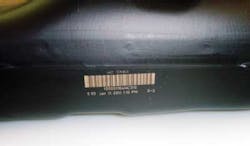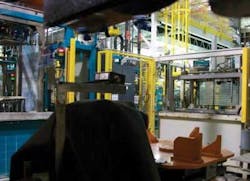Laser coding plastic fuel tanks
David A. Belforte
Replacing polyethylene labels reduces costs
Kautex Textron lays claim to being the first to develop and produce plastic fuel tanks for automobiles. Features such as corrosion resistance, lighter weight (so important in the drive to reduce overall vehicle weight and thereby increase fuel mileage), improved permeation behavior, recyclability, and expanded design options produce major advantages over steel tanks. As auto makers increased the sophistication of fuel systems to include decreased emissions, on-board diagnostics, and the ability to store alternate fuels, the tank makers increased the functionality and complexity of the systems. Kautex Textron met the challenge, and the company’s products are found in vehicles around the world. Today, more than 85% of all fuel tanks made in North America are plastic.
In Avilla, a small town located in northeast Indiana, Kautex Textron (www.kautex.de) operates a 70,000 ft2 plant with nine plastic tank manufacturing lines. Established in 1993 as the US branch of Kautex Textron GmbH Co KG of Bonn, Germany, a subsidiary of US-based Textron Corporation, the Avilla plant gained recognition in 2003 as an Industry Week Best Plant, where the company was cited for “higher expectations and a host of process improvements that powered them to world-class status” as one of America’s top plants.
ILS interviewed Gene Collison (IT site manager) and Glenn Suever (senior controls engineer) to learn about Kautex Textron’s use of lasers to replace polyethylene labels.
Tank construction
Tanks used to be a single layer of plastic that weren’t checked for volatile hydrocarbon emissions. Multi-layer tanks meet EPA standards for hydrocarbon emission levels even as the standards have been increasing over the years. Fuel tanks are composed of six layers of plastic, one of which is a barrier that protects hydrocarbons from evaporating into the air. This process is similar to multi-layer sandwich bags that keep moisture in and air out for freshness.
Kautex-built fuel systems are used on most of the world’s automobiles. In the US, the company now ships 1.2 million fuel tanks/year to companies such as GM, Ford, Chrysler, Toyota, and Honda. Auto companies buy on Just-In-Time inventory schedules so a breakdown on a tank manufacturing line can pose a serious logistical problem. Collison says that even though fuel tanks are containers of air, they take up a lot of room, so Kautex keeps their inventories low. Thus, if the company has a problem on a line, it can upset not only Kautex but also the JIT customer.
Kautex makes tanks from HDPE plastic with carbon black in the outer layer. The company laser etches the flat black, leaving a tan color that is optically legible and scannable by readers.
Kautex began by using printed polyethylene labels, but about two years ago for a Ford job, the company tried a diode-pumped Nd:YAG solid-state laser to etch labels onto the tanks. It did a good job producing legible text, but didn’t do as good a job on Code 39 barcodes. Kautex tried to optimize the laser process, but never could really get the Grade A quality it wanted for sharp lines for scanner reading.
Fiber laser introduction
As a result, Kautex invited ID Technology to demonstrate its Macsa F-9000 fiber laser with Windows-based Marca software. ID brought a system in and programmed it with some barcodes. Where it would have taken Kautex hours or days to get an acceptable bar code, it generated one almost immediately with this system.
Carbon black in the outer layer absorbs the fiber laser energy and changes color to a light tan, which has the contrast need for subsequent readout. The software is controlled to get good contrast without etching too deep, which might jeopardize the integrity of the tank. It also can negatively affect the edges of the barcode lines so that it makes reading difficult.
Laser-etched label marks must be readable for at least 10 years. The company maintains a database of tank production records that can be accessed for traceability or warranty situations. We asked if salt deposits from the road is an issue in mark legibility, but Collison said the requirement is to be able to read paper or polyethylene labels with the carmakers, so it is the same with a laser-etched label showing the Kautex data, in barcode format.
Asked what the laser etch benefits are compared to what is obviously a lower cost printed label, Collison and Suever list reductions in constant mechanical printer maintenance, cost of labels, cost of ink ribbons, and the time to replace label rolls. They point out the laser has a high capital equipment cost, but a low operating cost. The printer has a high maintenance cost; it’s expensive to shut the printed label machine down and start back up again, plus there is always some scrap on restart. With the laser, they get continuous running. They admit that the laser is expensive in the beginning, but the operating cost of the paper labels is offset by the lack of laser consumables. Perhaps more importantly is that with the laser they are guaranteed the information etched on the tank is for that tank, whereas labels could get switched or might get torn off in a reload operation. Management was in support of the laser from the beginning, setting aside the high investment cost when they saw the savings in operating costs over the printed label process. They wanted a process that worked and had lower maintenance costs.
Kautex includes some customer supplied data — date/time and part number — from its label in the laserThe Code 39 barcode is less than 4 inches in length. It is a 16 digit serial number and the best they can do is 20 characters. Code 128 or 2D would be more reliable, but they would have to change production line scanner controllers, which are not 2D barcode capable.
The company operates nine production lines, three of which use lasers. Kautex had looked at a fiber laser from the other laser vendor, but the results weren’t much better than the current solid-state lasers. The difference, Collison says, is the pulsing frequency output of the Macsa laser, which he thinks is critical for their applications.
Etching process
The current process is to laser etch at the beginning at the mold machine where the tanks are still hot, close to 80 degrees C, so they can’t be handled even with gloved hands. The tanks have been molded to shape, but the plastic has not yet set. The laser mark is used along the conveyor line to ensure that that process at each station has been completed properly.
It’s necessary that the laser etch be legible and readable by every piece of equipment on the Kautex manufacturing line. Each tank goes through about 5 to 6 manufacturing steps after the mold process. Verification scanners are mounted with the laser so that after being etched a robot brings the tank to a verification scanner where it’s determined if it works correctly. If not, an alarm signal sounds.
The cycle time per tank is about an hour, of which 45 minutes is in the cooling and stabilizing buffer operation. Laser etching, the next step, takes only 5 to 8 seconds depending on the label information. This is followed by a welding operation for valves. Next comes a fuel pump installation and a check for continuity, a pressure leak test, and then the placement of heat shields or other external components.
Kautex has been running its tank lines 24/7 for over a year. That’s why paper label changeover is a serious down time issue. The solid-state laser cooling systems need routine maintenance, but the air-cooled fiber laser does not, a blessing, as running at 24/7 the company would be forced to shut the line down for maintenance. When they get useable barcodes and no maintenance plus less worries, the use of the fiber laser makes good economic sense. The first fiber laser line was up and running the beginning of this year. A Honda job will be the first in production.
When asked if the company is satisfied with the fiber laser, Collison and Suever answer by saying that more fiber lasers are in the works, with two more purchased for a Ford line, and any new lines will be fiber laser if the customer approves of the process.
Fiber laser marker manufacturer
ID Technology (www.idtechnology.com) based in Fort Worth, Texas is the supplier of the Macsa fiber laser marking system. ID, a subsidiary of ProMach, designs, manufactures, and integrates custom identification systems, among them solid-state laser markers.
Mark Peet, ID’s regional manager for the Great Lakes area, says his company requested an opportunity to demonstrate the Macsa laser at Kautex after probing into their laser printing requirements. They brought their experience to bear on analyzing the laser printing issue that Kautex was experiencing with another supplier’s Nd:YAG lasers, and provided custom programming to interface the Macsa lasers with Kautex customer formats via Ethernet communications. They trained Kautex personnel on the Macsa Marca Windows-based software that allowed Kautex to easily dial in A Grade barcode printing quality to ensure customer satisfaction.
ID Technology believes that fiber lasers provide improved optical performance, better system flexibility, longer up-time, and higher reliability. They cite power consumption numbers for two 8-hour shifts running 365 days at $0.04/kW: $39.71 yearly for fiber and $1401 yearly for Nd:YAG. Power efficiency is up to 50% for the fiber and 2-3% for the YAG. Reliability is 100,000 hours MTBF for the fiber and 10 to 20,000 hours MTBF for the YAG.
David A. Belforte is the editor-in-chief of Industrial Laser Solutions for Manufacturing. He can be reached at [email protected].
Past ILS Issues



